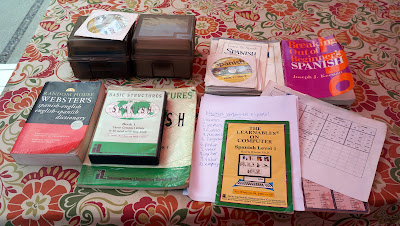Thursday, October 15, 2015
moving to mexico -- learning the language
I just took a big step in my Spanish studies.
Well, you may not think it is big. But it is big for me. I pulled out all of the language study materials and established a lingua franca cockpit on the courtyard table.
Like most people moving to Mexico, I had romantic dreams of becoming fluent in Spanish before I crossed the border. At least, fluent enough that I could amaze the attractive señorita at the local garden party with my grasp of the subtleties of Cervantes and his relationship with French existentialism. Of course, I would have been satisfied with my ability to introduce myself and get a telephone number.
I purchased two Spanish language computer programs. I think the first was from Costco -- with the usual promises of immersing myself in the language and speaking Spanish like a diplomat at the court of Charles V. I started and stopped. Learning little.
At the recommendation of the unfortunate Doug Bower, I purchased the first level of a Pimsleur-inspired program. The promise was that I would learn Spanish in the same manner as a three-year old from Puebla. I suppose that would be a three-year old from Puebla who continually listened and learned.
Once again, that was not me. I learned a few words. But I was no closer to discussing theology in Spanish with the village than I had been at the start.
When I left Oregon in April 2009, I was still functionally illiterate in Spanish. But I did receive a great gift the night before I left -- a comprehensive Spanish-English dictionary from Theresa Freeman (an early contributor to these pages).
Because I had not done my homework before heading south, I signed up for Spanish lessons with a local restaurateur. But my heart was not in the project. Professor Jiggs was dying at the time, and it was a bit hard to focus.
Even though I learned little Spanish, I did develop an effective learning tool (at the suggestion of Nancy, a fellow blogger). I filled an index card box of words and phrases I had encountered. The original plan was to keep the cards in the box until I learned the word or the phrase. All of the cards are still in the box.
So, I have plenty of learning tools. Unfortunately, they have been gathering dust for the past six years.
My Spanish has improved -- but only by osmosis. Waiters. Maids. Gardeners. Postal clerks. They have all added to the slow accretion of my Spanish. And I do get by on a daily basis.
But "getting by" is not my goal. Thus, the tools are out on the table.
Yesterday, my friend Ozzy stopped by. He is fluent in both Spanish and English. But he has no expertise in instruction. What he does have is an ability to talk me through some of the language questions I have. Like pronunciation.
Later today, I am going to set up a priority system. I plan to use the computer materials as a daily exercise to push my language envelope -- based on the structure of Breaking Out of Beginner's Spanish (a book wisely recommended by Kim, another fellow blogger). I will then use my index card box to expand my vocabulary. Ozzy's visits will then be an opportunity to put some meat on my language bones.
It is not a perfect plan. But it is a start. I want to get some discipline into learning Spanish. And it is certainly better than, as Anne Lamott puts it: "What good will it do to do nothing?"
Nine years after opening that first computer program in Salem, I am now off on my journey to discuss classic Spanish literature with the local literati. Or, at least, to remember the difference between quando and quanto which seems to have slipped my memory.
Subscribe to:
Post Comments (Atom)
